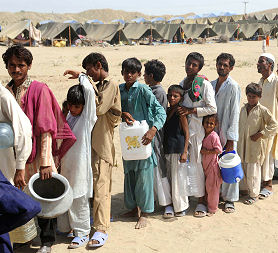Why this disaster just keeps spreading
Jonathan Miller writes on why the Pakistan flood disaster is far from over, and why helping tackle it is in the West’s interest.

While in Pakistan, reporting on the Great Flood of 2010, I was at first sceptical when I learned that the United Nations had declared it a greater humanitarian disaster than the Asian tsunami and the Haiti and Pakistan earthquakes combined.
I had covered the tsunami and the Kashmir quake for Channel 4 News and as a correspondent, both events were apocalyptic tragedies to report. I have a deep dislike of the idea of comparing natural disasters as though to rank one as “worse” than another. When you witness at first hand the human misery unleashed by these Acts of God, such comparisons seem crass and devoid of compassion.
But as I travelled through Pakistan, from the storm-lashed remote northern valleys of Swat to the vast inland sea that the Indus River had become in the south – through the malarial swamps where rural villages had once stood in between – the point of the UN’s comparison became startlingly clear to me.
Unlike with the other disasters, which were finite, one-off events, the Pakistan flood just kept on happening. As Mohammed Qazilbash of Save the Children in Pakistan put it to us: “The Asian tsunami and the 2005 earthquake were like heart attacks. This is like a cancer. It just keeps spreading.”
‘This is like a cancer. It just keeps spreading.’
The floods presented a nightmare to relief workers not because thousands were killed, but because so many survived. More than 20 million of them, many homeless, most without access to shelter, food and safe water. The threat of disease spreading as the contaminated water continues to inundate and submerge fresh areas of farmland and towns and villages.
In the days after the initial deluge, as I travelled with my producer, Nevine Mabro, and cameraman Graham Heslop, we encountered village after village whose inhabitants remained unreached, long after the water had receded. We were indignant that no help had got to these people and couldn’t work out why it was taking relief groups so long.
It slowly dawned on us that the absence of aid was simply an indicator of how huge the problem was. The Pakistan government, the army, the UN, the independent relief agencies were themselves completely swamped by the unprecedented scale of the disaster.
More than one month on from the torrential monsoon downpours which started it all, an official with the UN refugee agency was quoted as saying that the catastrophe facing two-million people in the remote southwestern province of Balochistan was being ignored.
“I have worked in humanitarian situations globally and worked in refugee camps in Africa during emergencies,” said Mengesha Kebede, “but to be honest I had never seen a situation as devastating as I saw in Balochistan.”
Even when the stinking flood waters have gone and people have returned to their wrecked homes to salvage what little is left, this catastrophe still won’t be over. There will be no harvest. There will be no planting (the seed crop has been destroyed). For 12-million people there still won’t be any food and there will be no work.
For 12-million people there still won’t be any food and there will be no work
And the world will have got bored watching this slo-mo disaster unfold.
But sustained compassion from the rich world for Pakistan’s rural poor is in the western world’s interest. Its strategic interest. Continued generosity could yet prevent Islamist charities from gaining further ground. The charities, with well-established links to militant insurgent groups, stepped in to aid flood victims in the absence of government assistance.
The more the West gives, the less likely it is that the people of Pakistan will be driven by sheer desperation into the welcoming arms of the Taliban.